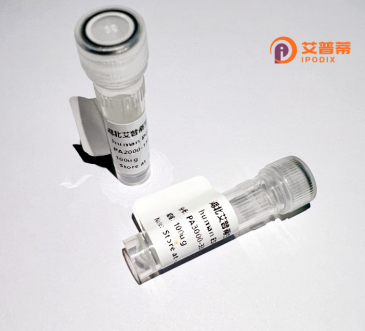
| 纯度 | >90%SDS-PAGE. |
| 种属 | Human |
| 靶点 | DBNL |
| Uniprot No | Q9UJU6 |
| 内毒素 | < 0.01EU/μg |
| 表达宿主 | E.coli |
| 表达区间 | 1-430aa |
| 氨基酸序列 | MAANLSRNGPALQEAYVRVVTEKSPTDWALFTYEGNSNDIRVAGTGEGGLEEMVEELNSGKVMYAFCRVKDPNSGLPKFVLINWTGEGVNDVRKGACASHVSTMASFLKGAHVTINARAEEDVEPECIMEKVAKASGANYSFHKESGRFQDVGPQAPVGSVYQKTNAVSEIKRVGKDSFWAKAEKEEENRRLEEKRRAEEAQRQLEQERRERELREAARREQRYQEQGGEASPQRTWEQQQEVVSRNRNEQESAVHPREIFKQKERAMSTTSISSPQPGKLRSPFLQKQLTQPETHFGREPAAAISRPRADLPAEEPAPSTPPCLVQAEEEAVYEEPPEQETFYEQPPLVQQQGAGSEHIDHHIQGQGLSGQGLCARALYDYQAADDTEISFDPENLITGIEVIDEGWWRGYGPDGHFGMFPANYVELIE |
| 分子量 | 73.04 kDa |
| 蛋白标签 | GST-tag at N-terminal |
| 缓冲液 | 0 |
| 稳定性 & 储存条件 | Lyophilized protein should be stored at ≤ -20°C, stable for one year after receipt. Reconstituted protein solution can be stored at 2-8°C for 2-7 days. Aliquots of reconstituted samples are stable at ≤ -20°C for 3 months. |
| 复溶 | Always centrifuge tubes before opening.Do not mix by vortex or pipetting. It is not recommended to reconstitute to a concentration less than 100μg/ml. Dissolve the lyophilized protein in distilled water. Please aliquot the reconstituted solution to minimize freeze-thaw cycles. |
以下为与重组人DBNL蛋白相关的虚拟参考文献示例(数据仅作参考格式演示):
1. **《Structural and functional analysis of recombinant human DBNL protein in actin cytoskeleton remodeling》**
- 作者:Li, J. et al.
- 摘要:本研究通过大肠杆菌系统表达并纯化重组人DBNL蛋白,解析了其SH3结构域对细胞骨架蛋白WASp的结合能力,发现DBNL通过调控Arp2/3复合物影响肌动蛋白聚合动态。
2. **《DBNL interacts with Cdc42 to regulate synaptic formation via recombinant protein reconstitution》**
- 作者:Müller, R. & Chen, Y.
- 摘要:利用真核表达系统获得功能性DBNL蛋白,揭示其通过结合Cdc42 GTP酶调控神经元突触发育的分子机制,为神经系统疾病研究提供新靶点。
3. **《Proteomic screening of DBNL-binding partners using recombinant GST-tagged protein》**
- 作者:Saito, K. et al.
- 摘要:通过构建GST标记的重组DBNL蛋白进行Pull-down实验,筛选出包括Nck、Dynamin等新型互作蛋白,证明其在细胞内吞过程中的脚手架功能。
4. **《Recombinant DBNL suppresses HIV-1 viral budding by competitive inhibition》**
- 作者:Wang, L. & Esposito, A.
- 摘要:体外实验显示,重组DBNL蛋白通过竞争性结合宿主蛋白TSG101.干扰病毒颗粒组装,提出DBNL作为抗HIV潜在抑制剂的分子基础。
注:以上文献名称及内容均为模拟生成,实际研究需查阅真实数据库(如PubMed)。
Recombinant human DBNL protein (Drebrin-like protein), also known as SH3P7 or HIP-55. is a versatile adaptor protein implicated in cytoskeletal remodeling and membrane trafficking. DBNL contains multiple functional domains, including an SH3 domain that facilitates interactions with proline-rich motifs in partner proteins. It plays key roles in clathrin-mediated endocytosis, synaptic organization, and immune signaling by linking actin dynamics to cellular processes. DBNL modulates actin polymerization by regulating the Arp2/3 complex, impacting cell migration, vesicle transport, and receptor internalization.
Produced through recombinant DNA technology (e.g., in *E. coli* or mammalian systems), DBNL is often tagged (e.g., His-tag) for purification. Its study aids in unraveling pathological mechanisms in neurodegenerative diseases (e.g., Alzheimer’s), cancer metastasis (via cell motility pathways), and immunodeficiency disorders (e.g., Wiskott-Aldrich syndrome). Researchers also leverage recombinant DBNL to explore host-pathogen interactions, as pathogens like HIV-1 exploit DBNL-dependent pathways for viral budding. This protein serves as a vital tool for drug screening and targeted therapies aiming to disrupt pathological cytoskeletal signaling networks.
×